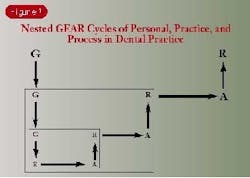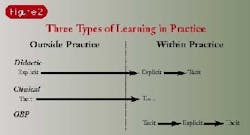Outcomes-based practice ... Part 6
by David W. Chambers, EdM, MBA, PhD
Dental practice - like any activity where performance excellence is based on improving repeated procedures - uses a cycle of Goals, Experiences, Assessment, and Responses. The quality of performance excellence is determined by the responses, and so far we have looked at six of them in the context of dental practice. At Level 0 Learning, dentists react in a superficial and unsystematic fashion; improvements are random. At Level 1 Learning, quality assurance techniques of inspection are the basis for reject and rework. This promotes efficiency, but short-term gains are followed by boredom. Three higher-level responses are possible in Level 2 Learning. By reconsidering the goals, redesigning the experiences, and reassessing how outcomes are measured, Level 3 responses work on the practice at a deep level and promote cycles of continuous improvement.
The seventh response in a GEAR learning cycle is reflection. Dentists can perfect their current level of performance through mindless repetition. In fact, the most stable performance is an automatic habit. But improvement requires performance coupled with awareness. And because this awareness usually involves mild discomfort and some ambiguity, many people have shut themselves off permanently from reflection. They still scan the journals, attend CE courses, and even read about evidence-based dentistry. But this approach to practice improvement is like downloading a computer file, picking up the handouts, or buying the tapes and then not using them.
Reflection is not the critical judgment of scientific literature. It is mindful, purpose-driven, and honest openness to what one is doing. It is always self-reflection. George Leonard, in his book, Mastery, calls it the "Mastery Attitude." Suzanne Langer, in her study of Mindfulness, demonstrates how disciplined self-awareness can even promote health. Thomas Kuhn, the classic philosopher of research, in The Structure of Scientific Revolutions, differentiates between "normal science" and "scientific revolutions." The grand promoter of doing things with one's mind turned on was a recently deceased MIT professor named Donald Schön, who studied architects, psychologists, city planners, and others to open up an understanding of the Reflective Practitioner.
Some speakers are knowledgeable and inspiring, and some are either one or the other. A few are neither. A knowledgeable speaker has something to say; an inspiring one makes you reflect about what he or she says and what it means to your life. There is a difference between practicing dentistry while wanting good things to happen and practicing dentistry with a reflective attitude.
Reflection is the bonus in cycles of continuous practice improvement that makes learning possible in a general way. It is also the key to providing meaning in a dental practice. It has already been suggested that practice takes place at multiple levels. The obvious ones are the level of individual procedures, the level of dental practice, and the level of personal fulfillment for patient and dentist. These levels are nested within each other; the pattern of procedures determines the practice and the pattern of practice determines personal fulfillment. (See Figure 1.) Align ment of these levels is important. Some dentists are dissatisfied with their practices, despite having enviable technical prowess or practice systems worth copying. There must be consistency throughout all levels.
The method used to ensure coordination of the personal, practice, and procedural levels of practice involves adding reflection to GEAR cycles. Reflecting on the outcomes of procedures drives improvement and alignment at the practice level. Reflecting on the outcomes of practice synchronizes this major life activity with personal goals. Dental practice, if not outcomes-based and enriched with liberal doses of reflection, is too apt to become dissatisfying, despite individual areas of excellence in procedures or practice systems.
People who study these things generally distinguish between two kinds of knowledge: explicit and tacit. Explicit knowledge is the kind we read in books and journals, rationally discuss with each other, and learn in school. It is in dental charts and insurance forms, directions for use of materials, and case presentations. It is expressed in words and numbers. By contrast, tacit knowledge is hard to talk about. It is how we tie a neck tie, decide whether a radiograph is diagnostic, recognize caries, or differentiate between a good day in the office and a bad one. It is the "style" of the expert and the "charisma" of the successful practitioner. Neither explicit nor tacit knowledge is superior, but the uses and limitations of each must be carefully understood to see how a practice can be improved.
Dental education and almost all continuing education - including research, EBD, and journals - work on the assumption of transmitting explicit knowledge from one person to another. It goes out of the heads and pages of the expert source into the heads of people who are not so smart. Since so little of a dental practice is based on explicit knowledge, continuing education in the traditional sense must be translated from the explicit knowledge that is easy to communicate into the tacit knowledge that practitioners can use in their unique situations. Hands-on courses are popular as a form of continuing education because they partially address this need. The vast majority of continuing education, and all of evidence-based dentistry, is a half-completed task. So far, the translation from explicit to tacit knowledge has been entirely under the control of individual practitioners. For the most part, this has been trial-and-error work.
There are ways of transmitting tacit knowledge from one person to another. It takes place in associateships, in study clubs, and especially in organized dentistry, where real-world politics and a lot of the business of dental practice are passed informally from generation to generation of practitioners through stories, examples, and collaboration.
The process of converting explicit knowledge to tacit knowledge is largely a matter of practice and the distillation and personalization of abstract ideas into concrete reality. Dentists, like all professionals, are especially good at this form of learning, although they receive little credit for it from their academic colleagues. Mandatory continuing-education requirements are predicated on the assumption that it doesn't take place as it should.
Classical continuing education transmits explicit knowledge and then hopes that professionals will personalize it into a usable tacit form. Outcomes-based practice uses a different model. The challenge of OBP is to convert tacit knowledge into an explicit form so it can be reflected upon and modified. Then it is converted back to tacit practice. All of this can take place within the dental practice. Figure 2 depicts three models of learning based on differences between explicit and tacit knowledge. Remember that practice is tacit and research is explicit.
Dentists require simple methods to bring important characteristics of their office routines into consciousness in an organized fashion. By reflecting on these important features of practice, improvement can be made, put in place, and turned into new and more effective habits. This is another definition of outcomes-based practice. The next six articles will present a series of such techniques.


